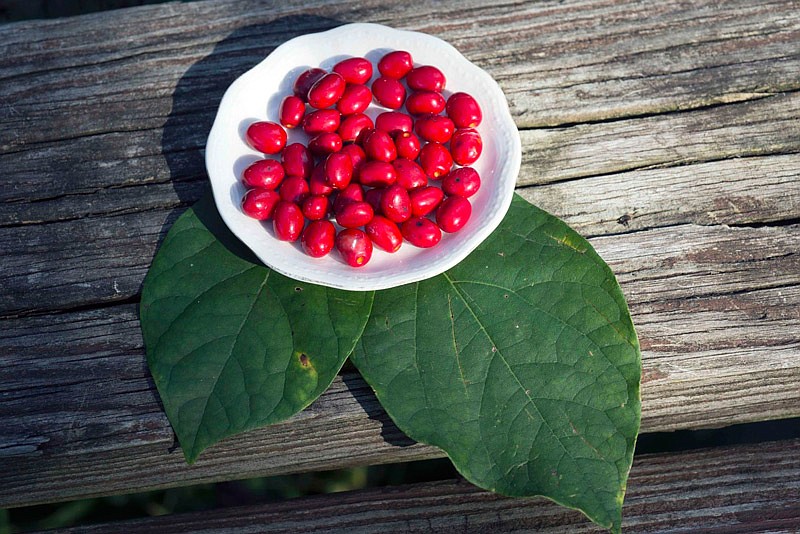Spicebush is a very aromatic plant - that is, the seeds and leaves contain compounds that have a distinct pleasant odor when crushed and contribute flavor to foods and beverages. In fact, that is one way to help identify the plant. Those nice-smelling leaves and twigs can be used for tea, and the bright-red berries are good to substitute in recipes that call for allspice with a hint of peppercorn flavor.
To prepare the tea, collect a handful of leaves (avoid collecting folded ones because there may be caterpillars using those leaves for protection). Cut the leaves in small pieces. For 3 cups of water, add 2/3 cup minced spicebush leaves. Boil for 15 minutes, let the infusion sit for a few minutes, strain and serve. Add honey and more water if desired.
To prepare the allspice substitute, dry the fleshy fruits (pulp and seed) and grind for use in recipes that call for allspice. The fleshy pulp of the fruit can be dried separately from the seed, if preferred, although it's more work. The pulp has the allspice flavor, and the seeds have a stronger flavor like pepper.
A 2009 article in Mother Earth News Magazine provides other options for using spicebush, including preparing an ice cream with spicebush berries. And Darrin Nordhal's book "Eating Appalachia" mentions beer and gin flavored with spicebush by local brewers. Use your imagination and experiment!
Those familiar with avocados, a tropical fruit, may find it interesting to learn that spicebush, as well as native sassafras, belong to the same family, the Lauraceae.
Spicebush is common in Missouri and is found naturally in more than half of the state's southern and east-central counties, growing as an understory shrub-tree in woodlands, especially in moist bottomlands. Spicebush can be found in most of the eastern United States. The botanical term for spicebush, Lindera benzoin, is named after the botanist Johan Linder, and benzoin refers to its aromatic nature.
In early spring spicebush flowers attract native bees, while the leaves provide nourishment to the spicebush swallowtail butterfly caterpillars. The attractive berries are consumed by more than 24 species of birds and nibbled by deer, rabbits and humans.
Because of its short stature (10-18 feet) and attractive appearance, this tree has ornamental value, especially in shade gardens. It performs better in fertile and moist soils with lots of organic matter. It can be grown easily from seed collected in the fall and exposed to a six-week period of cold-moist-stratification or from cuttings collected in the summer.
It is also available from local native plant nurseries in Missouri.
Since male and female flowers are in separate trees, to guarantee fruit production it is recommended to establish one male and one female plant. To assure this, you may need to establish grafted trees or those grown from cuttings, or plant several to assure having both. Rabbits and deer love spicebush, so it is a good idea to protect seedlings until their top branch is out of animals' reach. I use tall tomato cages to protect our bushes.
Spicebush has been very productive this year at the Lincoln University Native Plants Program. We plan to use the berries to flavor some of the appetizers to be served during the Dining Wild event Nov. 5. For more information about this event contact Maria Isabel Jacome at [email protected] or visit the Lincoln University Native Plants Program's Facebook page.
Nadia Navarrete-Tindall is an associate professor and native plant specialist for the Lincoln University Cooperative Extension. The Native Plants Program provides educational tools to students and the public on how to identify, grow and market native edible plants and those that are important to pollinators.

